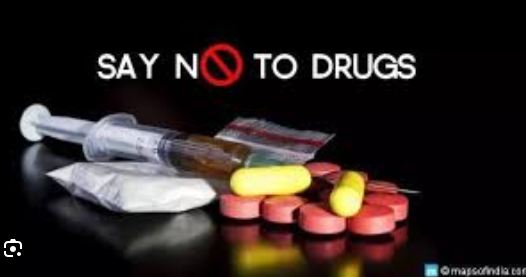Saifullah Ansar
Drug addiction rarely begins in a single way; rather, it emerges from multiple entry points that gradually pull individuals into dependency. One of the most common starting points is peer pressure, where friends or social groups introduce drugs during social gatherings, often under the pretense of enjoyment or bonding.
This exposure is particularly dangerous for young people, who are more susceptible to experimenting under the influence of their peers. Curiosity is another strong factor, as many individuals, especially teenagers and young adults, are tempted to “try just once” in order to experience something new or thrilling, without fully understanding the long-term consequences.
At the same time, drugs often become a means of coping with stress, depression, and unresolved emotional or family issues. In societies struggling with economic hardship, unemployment, and lack of social support, drugs can appear as an easy escape from daily struggles, providing temporary relief from pain and anxiety.
A family background where substance use is present also significantly increases the risk, as children exposed to such environments may grow up considering drugs a normal or acceptable part of life.
Furthermore, the media plays a powerful role in shaping perceptions, with movies, music videos, and social media often glamorizing drug use, presenting it as a symbol of confidence, rebellion, or even success. Such portrayals can make drugs appear attractive, especially to vulnerable and impressionable minds.
Initially, the effects of drugs may seem pleasurable. Users often report feelings of euphoria, relaxation, confidence, increased energy, and even heightened creativity.
These short-term sensations give a false impression of control and satisfaction, which traps individuals into repeated use. However, the reality quickly shifts as the negative consequences begin to outweigh the temporary highs. Common side effects include drowsiness, confusion, paranoia, anxiety, hallucinations, aggression, mood swings, and loss of rational judgment. With prolonged use, the body develops tolerance, forcing users to consume higher doses to achieve the same effect, eventually leading to full-blown addiction.
Globally, the most commonly abused substances include cannabis, cocaine, heroin, methamphetamines, and prescription drugs such as opioids, sedatives, and stimulants. In Pakistan, heroin, crystal meth (commonly known as ice), hashish, opium, and the misuse of prescription medicines like painkillers and sleeping pills are particularly widespread.
Easy availability, weak enforcement of drug laws, and cross-border trafficking make these substances accessible even to young people and students.
The disadvantages of drug use are devastating, both physically and socially. On the health front, drug addiction can cause irreversible damage to vital organs, including lung failure, liver cirrhosis, kidney malfunction, and heart disease. Brain damage is another severe consequence, as prolonged drug use alters brain chemistry, impairing memory, concentration, and decision-making abilities. Injecting drugs with shared needles exposes users to life-threatening infections such as HIV/AIDS and hepatitis B and C, further straining healthcare systems. Mental health also deteriorates drastically, with many addicts suffering from anxiety, chronic depression, schizophrenia, suicidal thoughts, and violent behavior.
On a social level, drug addiction is one of the leading causes of broken families, domestic violence, unemployment, crime, and social isolation. Addicts often lose the trust of their loved ones, face difficulties in maintaining relationships, and eventually disconnect from society. Legal repercussions add another layer of hardship, as arrests, imprisonment, and criminal records restrict future opportunities and lock addicts in a cycle of poverty and despair.
Preventing drug addiction requires a multi-dimensional approach involving families, educational institutions, communities, and governments. Awareness campaigns in schools, colleges, and workplaces are essential to educate young people about the dangers of drugs and equip them with the confidence to resist peer pressure. Parents must maintain open communication with their children, provide emotional support, and encourage healthy activities such as sports, arts, and community engagement.
Strict regulation and monitoring of prescription drugs are also necessary to prevent their misuse. Overcoming addiction is not easy, but it is possible with professional help. Rehabilitation centers play a crucial role in detoxification, therapy, and medical treatment, while counseling, support groups such as Narcotics Anonymous (NA), and skill-development programs help recovering addicts rebuild their lives. Family and community support remain vital throughout the recovery process, as acceptance and encouragement strengthen the will to stay drug-free.
According to estimates by the United Nations Office on Drugs and Crime (UNODC) and the World Health Organization (WHO), nearly 300 million people worldwide are using drugs annually in 2025, with around 40 million suffering from severe drug-use disorders that require treatment. In Pakistan alone, 7–9 million people are estimated to be drug users, with the youth between 15 and 35 years being the most vulnerable group. This alarming situation calls for urgent government action.
Authorities must strengthen border controls to curb smuggling, dismantle drug mafias, and implement strict punishments for traffickers. At the same time, expanding rehabilitation facilities, improving access to mental health services, creating job opportunities for youth, and using digital monitoring to track drug-related crimes are crucial steps.
Community policing, neighborhood watch programs, and collaboration with religious and social organizations can also help in raising awareness and discouraging drug culture. Ultimately, fighting drug addiction is not the responsibility of one sector alone; it requires a collective effort from governments, families, schools, media, and society at large.
Only through unity, education, and compassion can future generations be protected from the destructive grip of drugs.
The writer is a staff member

















